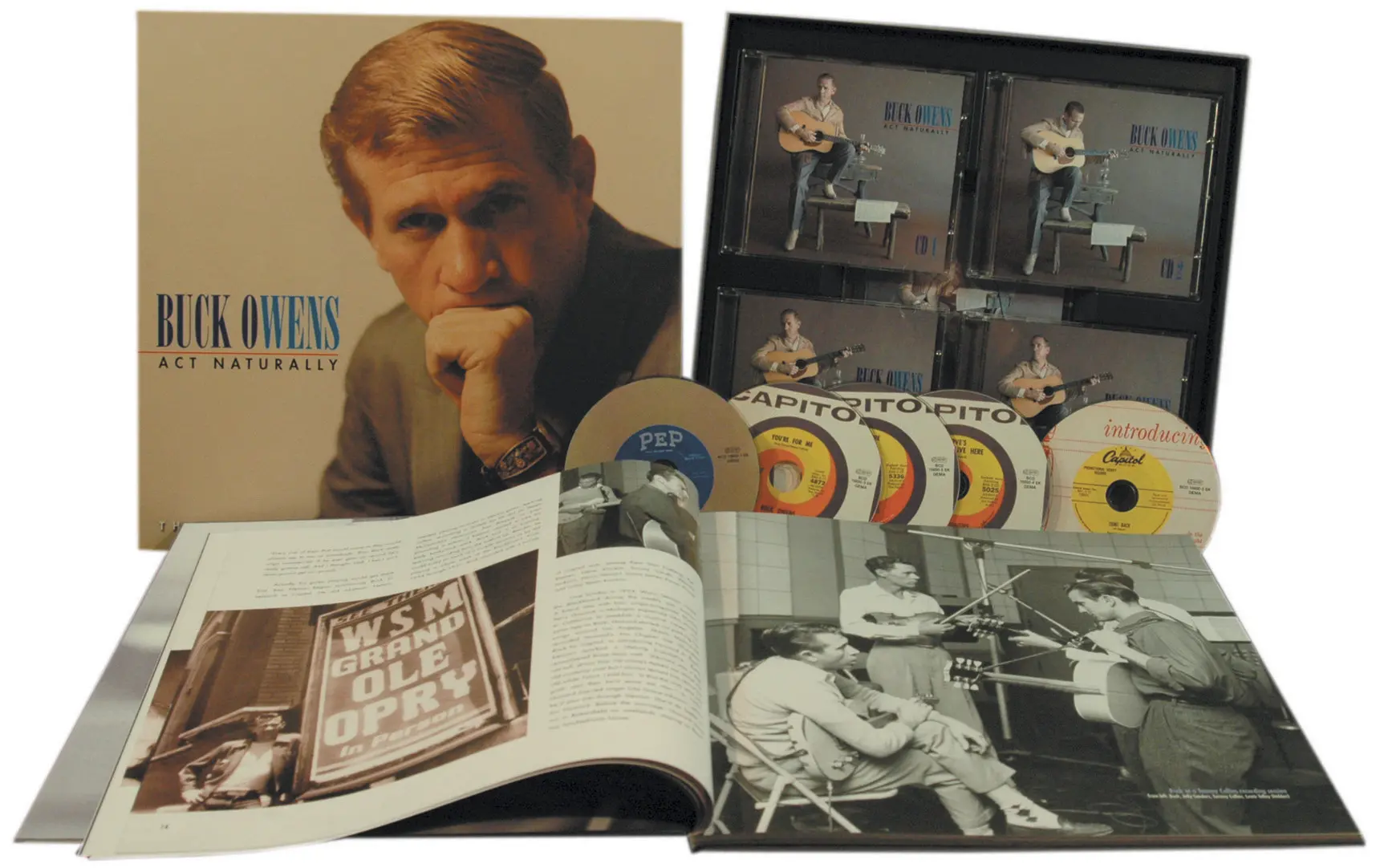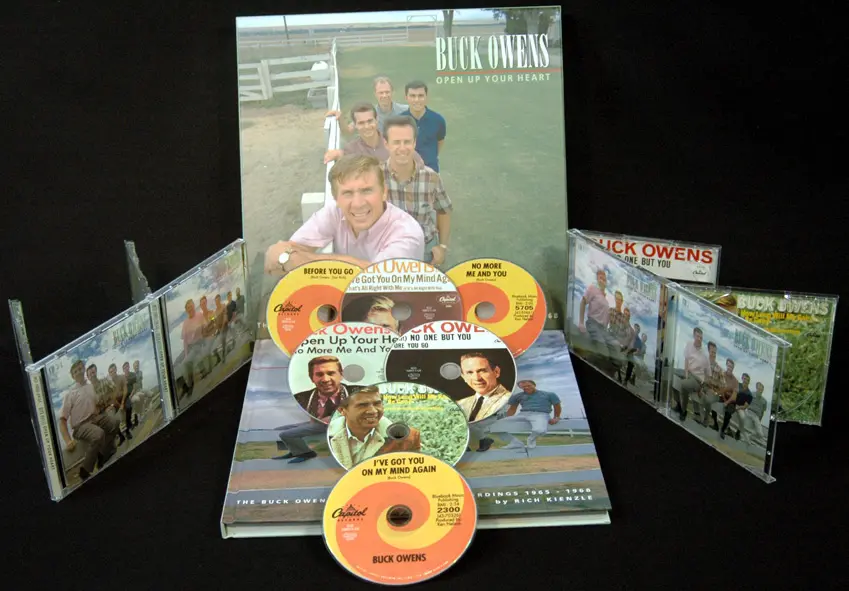Hee Haw Happy Times Are Here Again
"I've never been arrested, jailed, (or) taken dope. I've paid my taxes and I'yard proud of it."
Buck Owens, 1992
 Buck Owens worried about his legacy. A lot.
Buck Owens worried about his legacy. A lot.
Seventeen years co-hosting TV's 'Hee-Haw' with Roy Clark, pickin' and grinnin', telling incessant cornball jokes, introducing acts and singing his ain textile had himself made him a household proper noun. And yet, perception beingness 9-tenths of the police force, he feared the association would reduce his life and career to that of First Citizen of Kornfield Kounty, an affable buffoon in overalls singing Phfft! Y'all Were Gone with Archie Campbell or asking Grandpa Jones, "What'due south for supper?" The specter of that fabricated his claret run cold. Information technology's why he quit the show in 1986.
Buck knew damned well what he'd achieved. A principal honky-tonk singer who'd learned his trade playing for tips in Arizona honky-tonks then in Bakersfield's legendary Blackboard club, he created a distinctive, streamlined sound replete with catchy songs, embellished past twangy Fender guitars and a supercharged, aggressive rhythm he oft likened to a train rushing downwardly a rails. The results speak for themselves. 'Billboard' cites 26 Peak Ten singles plus 21 #1s, 15 of those between 1963 and 1967. Of the unbelievable 41 Capitol albums released from 1964 to 1974 including duet and all-time-of packages, 26 reached the Top X, 12 topping the country LP charts. Not only the premier country singer of the 1960s, he became a musical fountainhead revered by succeeding generations of country and rock acts.
Bakersfield had a land scene before Buck Owens ever arrived in 1951, merely Buck truly put it on the map. Blending the music around him with a joyous iconoclasm, echoing that of his heroes, Bob Wills, Hank Williams, George Jones, Elvis Presley, Chuck Drupe and Little Richard, he largely created the Bakersfield Sound, paving the style for both his own achievements and those of the as monumental Merle Haggard. Without trying, he inspired much of country's 1980s New Traditionalist movement, its nucleus of Dwight Yoakam, Marty Stuart, Highway 101, Keith Whitley and the Desert Rose Ring, all longtime Buckophiles. Yoakam, his greatest disciple, encouraged his mentor to cease his self-imposed semi-retirement, which culminated with his render to the phase and his 21st #one:
a 1988 duet with Yoakam on the obscure Buck oldie Streets Of Bakersfield.
 A newer generation of admirers arose in the 1990s, including The Derailers and others who drew inspiration from archetype Bakersfield
A newer generation of admirers arose in the 1990s, including The Derailers and others who drew inspiration from archetype Bakersfield
One of country music's shrewdest and most instinctively brilliant businessmen, his family unit-run empire encompassed vocal publishing and radio stations in both Bakersfield and Phoenix, as well as printing and publishing interests. When he sold the ii Phoenix stations in 1999, the toll was $142 million. Since he owned his Capitol masters (negotiated in his terminal contract in the 1970s), he made them bachelor again in the 1990s, further enhancing his musical stature. Despite his decades of openly criticizing Nashville's approach to country, the manufacture voted him into the State Music Hall of Fame in 1996. That twelvemonth, he also opened the Buck Owens Crystal Palace in Bakersfield, a $half dozen.7 million combination museum and supper guild, his own honky-tonk he could play whenever he wanted. Younger artists flocked to his side including Garth Brooks, Trace Adkins, John Berry, the Hot Lodge of Cowtown and Brad Paisley, himself no slouch with a Telecaster.
When he died on the morning of March 25, 2006 of a heart attack, following an impromptu performance at the Palace with the Buckaroos the nighttime before, obituaries and news stories abounded. While they didn't ignore 'Hee-Haw,' about concentrated non on the comic but celebrated the bold, innovative California honky-tonker who created raw, invigorating music for the ages, fulfilling his fondest wish for his legacy. In the stop, the world got it.
**********************
"Information technology was a existent tough life, but I hadn't known anything else. The whole family unit worked. It was hot, sweaty, grimy dingy piece of work and picayune pay."
Buck Owens
Grayson County, Texas sits along the Red River across from Oklahoma. Only southward of the urban center of Denison, forth the river, is Sherman, Texas. It was a pocket-sized boondocks in the late 1920s, when Alvis Edgar Owens, Sr., a native Texan and his wife, Arkansas native Maicie Azel Owens, tilled a nearby farm. Like so many others, they were sharecroppers struggling to make a living to support a growing family. Girl Mary was first, born in 1927. On Baronial 12, 1929 came Alvis Edgar Owens, Jr., followed by Melvin in 1931 and Dorothy in 1934. Alvis, Sr. occasionally worked at a dairy farm in Garland, Texas near Dallas. His eldest son never forgot his dad's difficult life, which became one of the motivating forces in his own. "You lot go up near two-3 o'clock in the morning time and go through about seven or 8. And 12 hours later you lot starting time all over. That'due south the worst kind of work a person can do. You have to do these ii shifts to go one mean solar day." On the farm, the Owenses had a mule named 'Buck' that Alvis, Jr. admired. When he was three or four, he walked into the firm and informed anybody his proper noun, thereafter, would be "Buck." And it was. Music took a chip of the edge off the family'south hard existence. Maicie, who played piano and guitar, exposed her kids to gospel music by taking them to various churches before joining a Southern Baptist Church.
The 2d they were onetime enough, the Owens kids headed into the fields with their parents. "We were sharecroppers . . . nosotros were a little bit of everything . . . farmed and tried to make something. (The country owner) furnished the seed and the state and nosotros furnished the labor. And you got a share of it, usually a 50-fifty basis on the profit and sometimes there wasn't a lot of turn a profit. In the thirties, it wasn't the desired matter. And along comes the 'Grapes Of Wrath' syndrome and blew everybody out." America's Great Depression aggravated that already-difficult life equally it wreaked havoc on most of the nation in the 1930s, complicated by droughts that struck rural Texas and Oklahoma and crippling dust storms that resulted wrecked countless farms and crops. Thousands of Texans and Oklahomans, facing certain starvation, uprooted and headed west.
Past November 1937, the Owenses had enough. Deciding their future lay in the Westward. Alvis Owens built a trailer to hold their belongings. He, his wife and kids, Buck's uncle Vernon Ellington and his wife Lucille, their infant son Jimmy and Maicie Owens'southward mother, Mary Myrtle--ten people in all--piled into a 1933 Ford sedan. Heading w, they stopped but to cook and to slumber. The trailer hitch disrepair as they rolled through Phoenix and, with relatives in nearby Mesa, everyone decided to stay. As itinerant farm labor, they worked on Arizona dairy and fruit farms and occasionally traveled to the rich farming regions in California's San Joaquin Valley, harvesting vegetables near Tracy, peaches near Modesto, carrots in Porterville, cotton and potatoes in Bakersfield. Alvis Owens drove trucks and dug ditches.
Buck Owens Human activity Naturally (5-CD)
Read more at: https://world wide web.bear-family.com/owens-buck-human action-naturally-five-cd.html
Copyright © Bear Family Records
Copyright © Bear Family Records®. Copying, also of extracts, or whatsoever other form of reproduction, including the adaptation into electronic data bases and copying onto any information mediums, in English language or in whatsoever other language is permissible only and exclusively with the written consent of Bear Family Records® GmbH.
More information about Buck Owens on Wikipedia.org
Source: https://www.bear-family.com/listing/manufacturer/sSupplier/113011

0 Response to "Hee Haw Happy Times Are Here Again"
Post a Comment